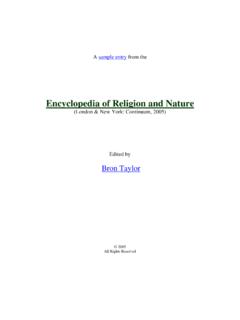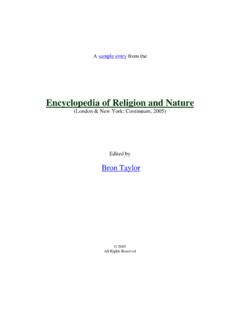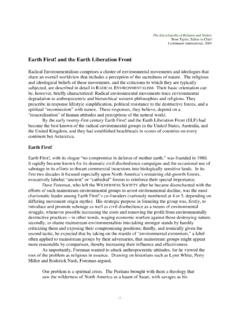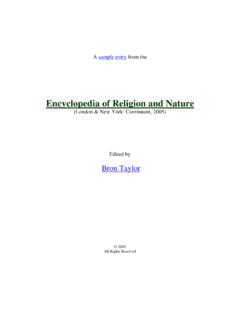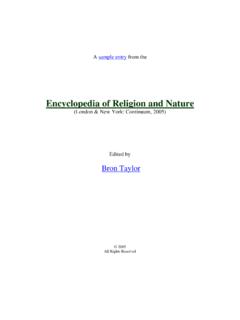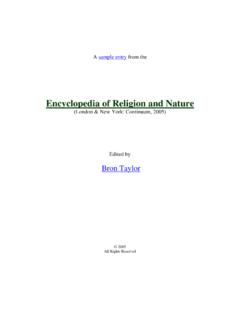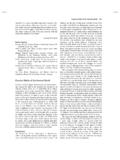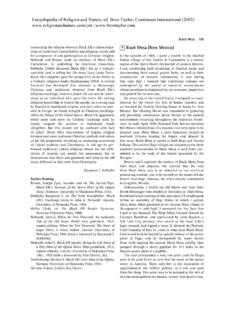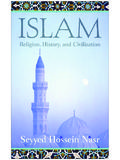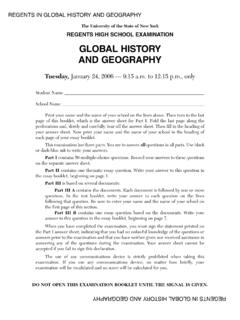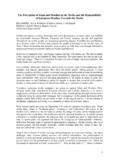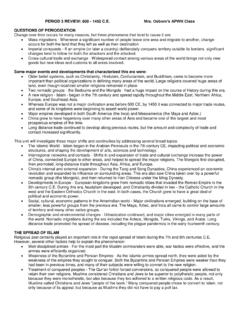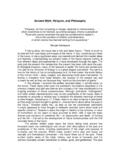Transcription of Encyclopedia of Religion and Nature
1 A sample entry from the Encyclopedia of Religion and Nature (London & New York: Continuum, 2005) Edited by Bron Taylor 2005 All Rights Reserved slaughter. Although killing a cock is allowed, the Prophetforbade reviling this fowl because it served the faithful byawakening them to perform their religious duty; the samerule applies to fleas who awakened a prophet. All three scriptures further condemn any manifestationof cruelty per se toward animals, which are recognizedas creatures of God; however, Judaism, Christianity, andIslam also encourage an instrumental approach toanimals, at best, while allowing their arbitrary killing, atworst. Perhaps this was the natural sequence in the processof turning the human race into the apex of divine creation,a creed that does not allow any partners of equal status atthe side of human beings.
2 Furthermore, teachers fromthese traditions condemn the practice of pet keeping,relegating the most favorite among the pets, especiallydogs, to the status of unclean or maligned animals. Suchantagonism may result from the apprehension of ecclesi-astical persons that attachment to pets which bestows onhuman beings a complete mastery over these creaturesand, in consequence, may bring about higher self-esteem might have detrimental consequences for the submissionof the faithful to an almighty God. No less important, theemotional linkage between a person and his/her pet mayweaken human dependence on God s representatives onEarth, the MenacheFurther ReadingHouston, Walter. Purity and Monotheism: Clean andUnclean Animals in Biblical Law. Sheffield: , , Ronald H. Animals in Jewish Thought and Tradi-tion.
3 Northvale: Jason Aronson, , Hyam. Ritual and Morality: The Ritual PuritySystem and Its Place. Cambridge: Cambridge Uni-versity Press, , Sophia. Dogs: A Story of Friendship. Societyand Animals 6:1 (1998), 67 , Sophia. Dogs: God s Worst Enemies? Societyand Animals 5:1 (1997), 23 also: Animal Rights in the Jewish Tradition;Animals; Christianity and Animals; Dogs in the Abra-hamic Traditions; Dogs in the Islamic Tradition;Elephants; Francis of Assisi; Hunting and the Origins ofReligion; Hyenas Spotted; Islam, Animals, and Vege-tarianism; Primate Spirituality; Serpents and by the anthropologist Tylor (1832 1917),the term animism refers not to a type of Religion but to atheory of Religion . Asserting a minimal definition ofreligion as belief in spiritual beings, Tylor argued thatreligious belief originated in the primordial mistake ofattributing life, soul, or spirit to inanimate it has generally been dismissed in the academicstudy of Religion as an obsolete term for describing thebelief systems of indigenous people who hold that naturalphenomena have souls or spirits, animism has neverthe-less persisted in popular usage and academic theory toraise problems about the meaning and value of materialityin s theory of animism was premised on a kind ofmaterialism, since he assumed that materiality by defini-tion was dead matter, but his theory was also framed interms of an ideology of European progress, underwrittenby evolutionary science.
4 Which bore a strange contra-diction. Although Europeans supposedly represented thepinnacle of evolutionary development, they could onlyknow that by comparing themselves to a baseline repre-sented by others who had supposedly not evolved. Likeother social evolutionists, Tylor found his evolutionarybaseline, the primitive, in reports submitted by Europeantravelers, missionaries, and colonial agents aboutindigenous people, the savage, on the periphery ofempire. While Europeans according to Tylor s evolution-ary scheme had progressed along a developmental trajec-tory through animism, polytheism, and monotheism toreach the highest achievements of science, evolving fromprimitive to civilized, indigenous people of the Americas,Africa, Asia, Australia, and the Pacific had supposedlybeen left behind by evolution, standing over as savage survivals of the Tylor was only interested in contemporaryindigenous religions as data for building a theory of theoriginal, primordial, or primitive animism, his termcaught on to such an extent that it became commonplacein European inventories of the religions of the world toidentify contemporary adherents of indigenous religionsas animists.
5 A recent guidebook for Christian missionaries,for example, asserts that 40 percent of the world s popu-lation is animistic (Van Rheenan 1991: 30). While thischaracterization has often been experienced by indigen-ous people as denigrating, it has occasionally beenadopted as a term of self-identification. In Indonesia andNigeria, for example, representatives of indigenous reli-gions, struggling in a political arena dominated by Muslimand Christian interests, have sought formal recognition asanimists. At the same time, animism has sometimes beenadopted as a term of self-identification in New Age,neo-pagan, or environmentalist movements. Withoutaddressing those appropriations of the term, this entryconcentrates on the history, rationale, and consequencesof animism as a theory of of AnimismDuring the nineteenth century, European social scientistsdeveloped different terms fetishism, totemism, and78 Animismanimism for the original Religion of humanity, buteach term carried the same allegation that primitives or savages were incapable of assessing the meaning andvalue of material term, fetish, for example, emerged out ofintercultural trading relations in West Africa in whichEuropean traders argued that Africans, unlike EuropeanChristians, had no stable system of value in which theycould evaluate objects.
6 Overvaluing apparently triflingobjects such as feathers, bones, and cloth used inritual, Africans undervalued the trade goods brought byEuropeans. In this context, European Christians referred toAfrican ritual objects as fetishes, a term derived from thePortuguese feiti o, referring to nefarious instruments ofmagic and witchcraft (Pietz 1985). The term, totemism, according to John Ferguson M Lennan, referred to com-munal alliances under the sign of an animal or an objectthat combined fetishism with exogamy, mixing theinability to evaluate materiality with regulations govern-ing sexuality (M Lennan 1870). Arguably, the term, animism, mixed fetishism not with human sexuality butwith animal psychology. The psychology of dogs, inparticular, provided the key to a theory of Religion basedon attributing animation to inanimate his popular survey of human evolution, The Origin ofCivilization and the Primitive Condition of Man, JohnLubbock explained that Religion originated as the result ofthe primitive tendency to attribute animation to inanimateobjects.
7 To illustrate this primitive frame of mind, Lubbock cited evidence from southern Africa, relying onthe early nineteenth-century report from the travelerHenry Lichtenstein that the Xhosa in the Eastern Capeassumed that an anchor cast ashore from a shipwreck wasactually alive. In a footnote, Lubbock observed, Dogsappear to do the same (Lubbock 1889: 287). As Lubbock sfriend and mentor, Charles Darwin, maintained, religioncould be explained in terms of dog behavior. LikeLubbock, Darwin observed that dogs characteristicallyattributed life to inanimate objects. His dog s attention to aparasol blowing in the wind, for example, suggested toDarwin that the animal assumed that objects were this animal psychology, therefore, nineteenth-centurytheorists had a basis for understanding animism as the primitive or savage propensity to attribute animationto inanimate of AnimismIn standard accounts, Tylor s theory of animism isderived from the primitive inability to distinguishbetween dreams and waking consciousness.
8 When the primitive ancestors of humanity dreamed aboutdeceased friends or relatives, they assumed that the deadwere still alive in some spiritual form. Out of dreams,therefore, evolved the doctrine of souls and otherspiritual beings in general, a doctrine that was rational, even if it was a childish philosophy enveloped in intense and inveterate ignorance (Tylor 1871: I, 22 3).Where did Tylor get his evidence to support this find-ing? Instead of observing dogs, Tylor collected accountsabout indigenous people, the savages who appearedin reports from European travelers, missionaries, andcolonial agents. Arguably, Tylor s most important sourcewas an account of Zulu Religion from South Africa,The Religious System of the Amazulu, which had been pub-lished under the authorship of the Anglican missionaryHenry Callaway, although the Zulu Christian convert,Mpengula Mbande, actually provided most of the reportscollected in the book.
9 Tylor praised The Religious Systemof the Amazulu for providing the best knowledge of thelower phases of religious belief (1871: I, 380).Certainly, Tylor found evidence of an active dreamlife among Callaway s Zulus. Zulus often saw the shadeor shadow of deceased ancestors in dreams. However,Callaway s volume included a detailed account aboutone Zulu man, an apprenticed diviner, who had becomeso overwhelmed with visions of spirits that he haddescribed his own body as a house of dreams (Callaway1868 1870: 228, 260, 316). According to Tylor, allZulus, as savage survivals of the primitive, weresubject to dream visions, but as for the man who ispassing into the morbid condition of the professionalseer, phantoms are continually coming to talk to himin his sleep, till he becomes as the expressive nativephrase is, a house of dreams (1871: I, 443).
10 AlthoughTylor appropriated him as an archetype of the primitive, this particular Zulu man, who served Tylor asa savage survival of the original house of dreams from which Religion originated, was James Mbande,the brother of the Christian convert, Mpengula his brother, James was torn between the Christianmission and indigenous tradition. While Mpengula wentone way, becoming a catechist for the mission, Jamesstruggled in the other direction, striving to keep anancestral dream alive under increasingly difficultcolonial conditions. In this case, therefore, the houseof dreams was not a primitive, but a colonialsituation, the product of contemporary conflicts insouthern analysis of dreams, however, did not provide theonly evidence for Tylor s theory of animism.
